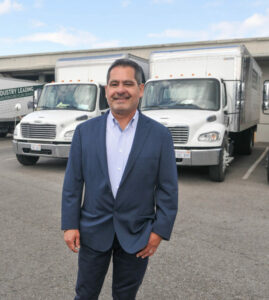During a time of upheaval in the Los Angeles office market, one company is benefiting by readying the interiors of office buildings for their next phase of life.
IRS Demo — “IRS” stands for Interior Removal Specialist — specializes in the interior demolition of high-rise buildings, preparing the spaces for new tenants or leases.
A large part of the company’s work involves recycling material that its workers remove from the buildings, everything from construction components to office furniture.
“We’re about 10 to 15 years ahead of everybody,” said Carlos Herrera, founder and chief executive officer of the South Gate-based company. “The way the state legislature has written to recycle construction and demolition debris is based on weight. Everyone is recycling concrete, asphalt and dirt because that’s where the weight is. The real toxicity is the carpet, the manufactured lumber and drywall. When you bury drywall, it releases sulfurs and sulfite gas, but if you crumple it up and use it as a soil amendment and let air get to it, it actually works very well for the almond farmers. That’s where we’re sending all of our drywall to recycle.”
Big jobs
By its own estimation, IRS Demo has demolished 50 million square feet of office space, created more than 600,000 tons of debris and diverted — or recycled — more than 456,000 tons of materials from landfills. In addition, it has donated more than 5,800 tons of material, furniture and fixtures to organizations in Los Angeles and Mexico.
Herrera’s company has handled interior demolition work for more than 700 clients, including Apple, Google, Activision, Red Bull, CBRE Group Inc., Cushman & Wakefield, Jones Lang LaSalle, SAG-AFTRA, Directors Guild of America, Wells Fargo and City National Bank.
Nine times out of 10, he said, a client will tell him that the furniture in a building the company works on will be removed before IRS workers arrive.
“It’s never gone,” Herrera said. “They’ll leave half of it behind. We have to get it out of the way, so we’ll get all the furniture out, carpet, doors and frames, drywall and ceiling. We touch everything when we do these projects, we’re plumbers, we’re electricians, we’re air condition, fiber optics. It’s definitely a tough procedure. What helps us is that we’re segregating the materials on the job. We’re putting the carpet in one bin and we’re sending that out to be recycled. We’re bringing in the drywall in another bin and we send that off to the farmers. The manufactured lumber, which is the most toxic material out there, we send that to a company in Ontario that makes little pellets and sells them to refineries.”
Work experience
Herrera’s path to the interior demolition industry came about from a childhood spent recycling bottles and cans with his family to get by. At one point, his mother was able to afford a 1960 Rambler.

“We took out all the seats in it,” Herrera said. “My mom started to go to the different neighborhoods during the day on trash day. We started from a shopping cart to a Rambler to a truck to two pickup trucks.”
Things changed for Herrera when his mother was involved in a car accident. He was 18, and had to go looking for work.
“I got a day job, I was hired by a developer downtown,” Herrera said. “I started as an elevator operator and did janitorial at night. On weekends, any subcontractors that needed extra labor, I would always say, ‘Hey, I need (overtime).’ I got promoted pretty quickly. I understood the value of what other people were not seeing, and that was the value of the reuse of the materials and some value to the metals.”
Herrera was promoted and became a superintendent in construction.
“So from the age of 18 to 24 I worked for the developer,” Herrera said, “working on 10 different high-rise buildings, three major hotels. Just remodeling.”
When Herrera was 24, the developer decided to sell the portfolio.
“One of the tenants said, ‘Hey, why don’t you become a contractor, you’re really good, I’ll give you this big job.’”
An opportunity
Herrera had not planned to start his own business.
“The opportunity presented itself and I decided to take it,” he said.
During the first two years, Herrera did tenant improvement work and gradually started to get into interior demolition.
“After a couple of years with a partner, times got tough, it didn’t work out, he took off to do construction and I started IRS Demo,” Herrera said.
“My first goal was to see if we could do half a million in sales and in our first year; we did $1.5 million.”
That was 30 years ago, and Herrera has been in business with IRS Demo ever since, not that there have not been ups and downs.
The pandemic, of course, negatively impacted his business, he said.
“Our revenue went half,” Herrera said. “Pre-pandemic, we were up to 300 people. Everything came to a screeching halt. We did whatever we had to do to stay alive. It was brutal. Now we’re back to 200 people. It just opened back up (after the end of the pandemic).”
Herrera said the office market’s instability has not had an appreciable effect on his company.
“For the most part, we’re doing office buildings, but we’re seeing a spike in malls and retail,” Herrera said.
Mike Soto, research director of Savills, said IRS Demo’s comeback is in line with current office trends.
“Usually, those types of businesses crush it when there’s a lot of leasing going on,” Soto said “Leasing is up since the pandemic, but it’s still lower than it was pre-pandemic.”
